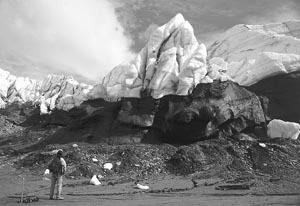Field Forum
Report
Glaciohydraulic Supercooling, Basal Freeze-on, Stratified Basal Ice and "Deformable Till Beds": Matanuska Glacier, Alaska
Conveners:
Edward B. Evenson, Earth and Environmental Sciences, Lehigh University, Bethlehem, PA 18015
Daniel E. Lawson, Cold Regions Research and Engineering Laboratory, Hanover, NH 03755
Grahame J. Larson, Geological Sciences, Michigan State University, East Lansing, MI 48824
Richard B. Alley, Geosciences, Pennsylvania State University, State College, PA 16802
 Matanuska Glacier |
Geoscientists have long known that the best insights come at outcrops and exposures. The GSA Field Forum is a new approach that combines the traditional observations of a field trip with the targeted scientific discussions of a Penrose or Chapman Conference to advance the understanding of a particular topic across an important segment of the community. Recent debates concerning the nature and importance of deformable beds, ice-bed interactions, and glaciohydraulic supercooling and its role in debris entrainment and transport made a field forum focused on subglacial processes timely, especially with respect to the flow and dynamics of former ice sheets. Altered basal conditions can cause hundredfold or larger changes in ice-flow speed, and paleoclimatic records show that such changes have occurred in the past. Basal conditions also play a critical role in debris entrainment and transport. In particular, debris fluxes associated with Heinrich events and till transport and deposition emphasize the importance of understanding processes occurring at the glacier bed. Many important questions regarding the origin, deformation, and evolution of basal ice and subglacial sediment still remain unanswered and require a multidisciplinary approach by earth scientists with diverse backgrounds. The recent recognition that onset of glaciation can increase erosion rates by 1-2 orders of magnitude has further focused attention on glacier-bed processes because of the clear need to include glaciers in the models of mountain belts and global biogeochemical cycling. Finally, it is only by reviewing field evidence, data, and models of basal processes of modern glaciers that we can hope to understand the erosional, depositional, and landform record of former ice sheets and predict the behavior of modern glaciers and the Greenland and Antarctic ice sheets.
The first GSA Field Forum convened in Alaska, March 18–22, 2000. The logistics of winter field work (temperatures of –40 °F are common this time of the year at the Matanuska Glacier) and severe lodging limitations required restricting participation to 27 people, including the leaders.
Spectacular weather, combined with the excellent winter exposures produced by ice marginal uplift, sublimation, and wind etching, allowed an international group of glacial geologists, geomorphologists, sedimentologists, geophysicists, geochemists and glaciologists to simultaneously examine, discuss, photograph, and sample the basal and subglacial facies of the large, active, and well studied Matanuska Glacier.
Participants traveled to the Matanuska Glacier with six stops along the Matanuska Valley to photograph and discuss the modern Matanuska outwash system and deglacial features of the Knik-Matanuska glacial system. A hike to the glacier margin allowed participants to familiarize themselves with the ice-marginal conditions and plan appropriately for the next three days at the ice margin.
Previous work at the Matanuska Glacier has shown that during the summer melt season, pressurized subglacial waters flowing from overdeepenings supercool and grow ice on the glacier's base, trapping debris (mainly silt) and forming laminated basal-ice sections several meters thick. Ice flow during the winter is not balanced by the slow sublimation, so the ice margin upthrusts to produce superb exposures of both the laminated, basal freeze-on ice and the frozen-on subglacial deforming bed.
In three days of study, participants tested the evidence and implications of glacier growth on the bottom. A demonstration of sampling protocols involving a cement saw produced new samples. Grahame Larson has used these to confirm earlier work showing bomb-produced tritium in basal ice underlying tritium-free older glacier ice, demonstrating the recent origin of the underplated material. Associated samples have been analyzed by participant Thure Cerling for their gas (3He) composition, and large anomalies from atmospheric concentrations attest to the complex processes occurring during and after ice accretion. The clear evidence of metamorphic processes in some, but not all, basal ice generated vigorous discussion on the relative importance of accretional processes and postaccretion modification in generating the observed layering. Everyone agreed that we are still confused, but at a much higher level! Staci Ensminger summarized her results showing that debris bands crosscutting the body of the glacier are basal crevasses charged by silt-laden basal waters, and several participants related consistent observations from other glaciers.
The late-winter sun triggered debris flows from basal ice and seasonally frozen-on subglacial till, and observations of the flows illustrated the linkage between basal ice and morainal deposits. Comparison of the nascent deposits to the prominent Little Ice Age moraine and other sediment accumulations clearly showed the geomorphic importance of the active processes.
Talks by the convenors and field trip guide editors Jeff Strasser and Staci Ensminger linked the wintertime observations to summertime processes and to a wealth of other data collected over decades of work on the glacier. The talks also emphasized the physical basis for expecting that supercooling beneath overdeepened glaciers is a widespread process, with implications for glacier erosion, sedimentation, and motion. Talks contributed by Matt Roberts and Jay Fleisher then demonstrated features from Iceland and coastal Alaska quite similar to those of the Matanuska Glacier, while John Anderson showed tantalizing records from the Antarctic continental shelf at least suggesting the possibility of related processes there.
On Thursday, participants were given the morning and snowmobile transportation to visit and sample exposures of basal ice visited earlier. Many participants took advantage of the spectacular weather and the two available Super Cubs to fly up the Matanuska and into College Fjord in Prince William Sound, and several made ski landings in the Matanuska snowfields. Other participants switched to structural geology and concentrated on the beautifully exposed thrust features of the ice margin.
Acknowledgments
We thank Laura Cambiotti (Lehigh University), Tony Carter (Copper Whale Inn, Anchorage), Jodi Talcott and staff (Majestic Valley Wilderness Lodge), and Bill and Kelly Stevenson (Glacier Park). The Cold Regions Research and Engineering Laboratory cosponsored the forum. The National Science Foundation funded the participation of students and key invited participants. Jeff Strasser and Staci Ensminger wrote the guidebook and provided invaluable logistical and scientific support, and Jay Fleisher provided the photograph included in this report.
Forum Participants
| Richard Alley John Anderson Greg Baker Derek Booth Geoff Boulton Thure Cerling Jim Cotter Kurt Cuffey Jane Dionne |
Don Easterbrook Staci Ensminger Ed Evenson Jay Fleisher Dru Germanoski John Gosse Bernard Hallet Ardith Hansel Alan Knueble |
Grahame Larson Dan Lawson Tom Lowell Dave Mickelson Peter Moore Carrie Patterson Matthew Roberts Jeff Strasser Slawek Tulaczyk |





